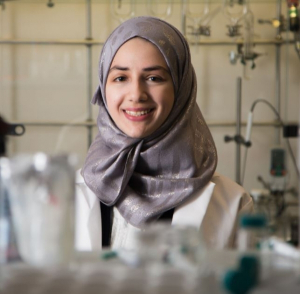The chances of not winning a National Science Foundation (NSF) research fellowship are much greater than walking off with the coveted award. The odds go down substantially if you’re still an undergraduate who hasn’t yet been accepted to graduate school. But Rawan Almallahi, a Cullen College senior majoring in chemical engineering and student of the Honors College, is accustomed to winning, and so as she continues to hear back from graduate schools, she lets them know that she’ll be coming aboard with the NSF prize wrapped up.
The NSF fellowship is often credited with helping recipients become life-long influencers who contribute meaningfully to both scientific innovation and teaching. Many Nobel Prize winners are past fellows as are Google founder Sergey Brin and Freakonomics co-author Steven Levitt.
"Rawan is a talented undergraduate researcher in my laboratory and highly deserving of this prestigious award," said Megan Robertson, assistant professor of chemical and biomolecular engineering. "The NSF graduate research fellowship will provide many opportunities to Rawan as she pursues her doctoral degree."
This year more than 13,000 applicants competed for 2,000 awards. Of the winners, 700 were seniors in college. The fellowship includes three years of funding at $34,000 per year, plus $12,000 in cost-of-education allowances paid to the school. Almallahi won her award for research in the field of deriving epoxy resins from a renewable source, the subject of her senior research paper.
“Epoxy resins have a wide variety of applications,” said Almallahi. “They go from being used as composites in wind turbine blades to adhesives and electrical and automotive components.” The problem with the traditional epoxy resins used in industry today, Almallahi says, is that they are developed from bisphenol-A, a non-degradable chemical which is harmful both to human health and the environment.
Almallahi is working to find a new source that is degradable and not harmful.
A full-time winner
Along with her research proposal about epoxy, Almallahi had to submit a personal statement for the NSF application. She chose to talk about her photography.
She was a freshman when she won first place in a photography competition called “Open the Door.” Her winning entry was a photo featuring keys peeking out beneath a doormat with an accompanying quote she wrote offering that your success, or open door, may be right beneath your feet. You just have to keep looking.
Almallahi never stops looking for her chances to succeed. Last summer she attended a prestigious summer biotechnology research program at Harvard. She was also a finalist for a Marshall scholarship. Now she’s set on convincing more students to conduct research.
“I want to inspire more people to do research, especially minority students and female students,” she said.
With all her successes, her inspiration will probably stick. Like epoxy.
